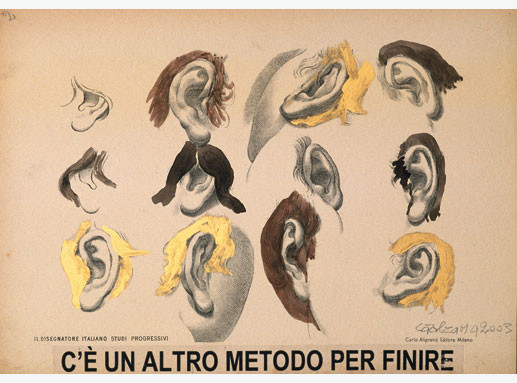Carol Rama
21 Apr - 24 Jun 2012

© Carol Rama
C’è un altro metodo per finire, ancora, 2003
pastel, watercolours and enamel on paper on canvas
24.5 x 34.5 cm
Courtesy Galerie Isabella Bortolozzi
C’è un altro metodo per finire, ancora, 2003
pastel, watercolours and enamel on paper on canvas
24.5 x 34.5 cm
Courtesy Galerie Isabella Bortolozzi
CAROL RAMA
Böse Zungen
21 April – 24 June, 2012
With Carol Rama (born 1918), the Kunsthalle Düsseldorf is organising the first institutional exhibition in the Rhineland for one of the most extraordinary artists of her generation. The oeuvre of the Italian artist, who was awarded the Golden Lion for her life’s work at the 2003 Venice Biennale, is characterised by a radical breaking of taboos. Her dealings with the body and sexuality in her openly sexual watercolours from the 1930s anticipate themes that became important for action and body artists of the 1960s and 1970s. Her sensitive, often ironic drawings, collages, object pictures and watercolours, which the artist continues working on today, are equally shocking and elegant, rebellious and eccentric. Personal memories and early familial burdens, sexual notions and all kinds of everyday fetishising objects, myths and the present merge into a cosmos of its own in Carol Rama’s work that mirrors tendencies in post-war modernism but has preserved its own strong sense of individualism.
The exhibition understands itself as a solo presentation that is nevertheless thematically linked to the Yüksel Arslan (born 1933) retrospective that is simultaneously on show at the Kunsthalle Düsseldorf. A presentation of a selection of the early drawings by the Montenegrin artist Dado (1933-2010) is also being planned. Despite the idiosyncratic nature of these three oeuvres and their very different artistic vocabularies, they do overlap to some extent in terms of themes and pictorial worlds, making it sensible to present them in a joint context: the obsessive and unfathomable, motifs of dreaming, playing, sexuality, violence and dismemberment, the body as fragment and fetish.
Carol Rama employed images of “experienced“ objects and fragmented body parts such as shoes, shaving brushes, sets of teeth, tongues and eyes, which she arranged into new, often enigmatic images. She transformed fetishist sexuality, unfathomable fantasies and fears as well as bodily deformations and mutations into a puzzling poetic that is unprecedented in its mixture of naivety and boldness and which surmounts the Surrealist or Dadaist quotation. In the early 1970s, she discovered rubber as new working material for herself. Wear marks lend painterly qualities to old bicycle tyres, enabling them to tell their own stories as authentic fragments. The resulting collages and sculptures are close to the material sensitivity of Arte Povera, recalling Neo-Dadaist or Neo-Realistic tendencies in their
assemblages of everyday items and Surrealist poetics through the erotic charging of the protruding valves. Carol Rama uses old maps or engineering drawings as the support for her pictures since the early 1990s, the structures of which she contrasts with her own pictures in a recourse to early pictorial inventions.
The exhibition is accompanied by a publication.
Böse Zungen
21 April – 24 June, 2012
With Carol Rama (born 1918), the Kunsthalle Düsseldorf is organising the first institutional exhibition in the Rhineland for one of the most extraordinary artists of her generation. The oeuvre of the Italian artist, who was awarded the Golden Lion for her life’s work at the 2003 Venice Biennale, is characterised by a radical breaking of taboos. Her dealings with the body and sexuality in her openly sexual watercolours from the 1930s anticipate themes that became important for action and body artists of the 1960s and 1970s. Her sensitive, often ironic drawings, collages, object pictures and watercolours, which the artist continues working on today, are equally shocking and elegant, rebellious and eccentric. Personal memories and early familial burdens, sexual notions and all kinds of everyday fetishising objects, myths and the present merge into a cosmos of its own in Carol Rama’s work that mirrors tendencies in post-war modernism but has preserved its own strong sense of individualism.
The exhibition understands itself as a solo presentation that is nevertheless thematically linked to the Yüksel Arslan (born 1933) retrospective that is simultaneously on show at the Kunsthalle Düsseldorf. A presentation of a selection of the early drawings by the Montenegrin artist Dado (1933-2010) is also being planned. Despite the idiosyncratic nature of these three oeuvres and their very different artistic vocabularies, they do overlap to some extent in terms of themes and pictorial worlds, making it sensible to present them in a joint context: the obsessive and unfathomable, motifs of dreaming, playing, sexuality, violence and dismemberment, the body as fragment and fetish.
Carol Rama employed images of “experienced“ objects and fragmented body parts such as shoes, shaving brushes, sets of teeth, tongues and eyes, which she arranged into new, often enigmatic images. She transformed fetishist sexuality, unfathomable fantasies and fears as well as bodily deformations and mutations into a puzzling poetic that is unprecedented in its mixture of naivety and boldness and which surmounts the Surrealist or Dadaist quotation. In the early 1970s, she discovered rubber as new working material for herself. Wear marks lend painterly qualities to old bicycle tyres, enabling them to tell their own stories as authentic fragments. The resulting collages and sculptures are close to the material sensitivity of Arte Povera, recalling Neo-Dadaist or Neo-Realistic tendencies in their
assemblages of everyday items and Surrealist poetics through the erotic charging of the protruding valves. Carol Rama uses old maps or engineering drawings as the support for her pictures since the early 1990s, the structures of which she contrasts with her own pictures in a recourse to early pictorial inventions.
The exhibition is accompanied by a publication.
